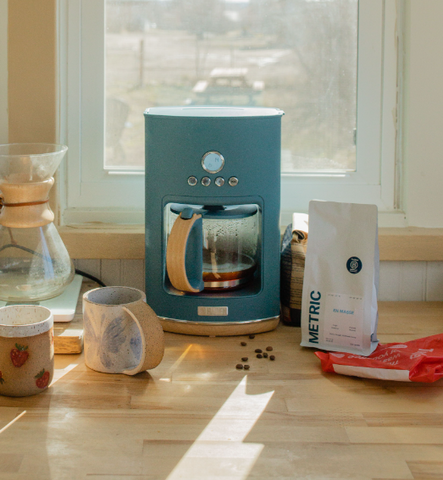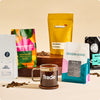How to Make Coffee in a Coffee Maker
Make the perfect coffee at home every time with these expert coffee maker tips.
You have to start somewhere, and the classic automatic drip coffee maker is an excellent place for beginners (or coffee drinkers of any skill level). A go-to for good reason, drip machine brewing is consistent, easy, and versatile enough to work with any coffee you like. But don’t confuse simple for basic — you can expect delicious coffee, easily on par with most manual methods. The secret’s in the right grind, proper cleaning, and filtered water. While this coffee recipe is specifically for a 10-cup coffee maker, you can easily adjust it for different amounts of coffee. Simply divide the water volume and coffee weight by the same number (E.g., 625 milliliters of water to 40 grams of coffee). Read on and learn how to use a coffee maker to its fullest potential.
What You Need
- Coffee Maker (we're using a 10-cup)
- Paper Filter (cone or wavy basket)
- 45 oz / 1331 ml filtered water
- 2.75 oz / 78 g of medium ground coffee. Don't have a grinder? We can grind it for you!
Getting Started
1. Add Water
- If you can run your tap water through a basic water filter, that’ll produce the best results.
- Bottled water works great too!
- Distilled water won’t do a great job, as your water does need some minerals to extract those tasty flavors. You can absolutely use the markings on your drip coffee maker or its carafe to measure water, but if you have a scale handy weigh your water for added consistency (1 ml of water weighs 1 gram). A fun idea to play with for the summer: use half as much water as usual and weigh out a half batch of ice (for this recipe, 625 g) directly in your coffee pot. The coffee will drip onto the ice for flash-chilled iced coffee.
2. Prep Filter
If your drip coffee maker uses a cone-shaped filter, fold the crimped edges in opposite directions before placing it in the filter basket. If you’re using a wavy, flat-bottomed filter, place it inside the filter basket as is. Some coffee makers come with a reusable stainless steel filter; if that’s the case, no prep is needed.
3. Brew Coffee

If you have a bag of pre- ground coffee, just skip right over to the next paragraph. If you’re grinding fresh, start with a medium coffee grind size (some grinders have a specific “drip” setting). Since most home coffee makers don’t let you adjust settings like time and temperature, changing grind size is one of the most important ways you can influence coffee taste.
Make sure to note your coffee grinder setting, so you can either repeat it or make an adjustment next time you’re brewing coffee. Blade grinders don’t have the same types of settings as a burr coffee grinder, so if you’re using one of those, try to grind until most of your particles look roughly the size of sand.
Add your grounds to the coffee filter and place the basket back inside the machine.
Turn on the machine and wait for the brew cycle to complete. Your machine may have extra features like a “strength” selector, but our recipe works best at the default setting (and if you want coffee that’s weaker or stronger than our recipe, you can always adjust the amount of coffee next time). Coffee brewing should take between three and five minutes on most machines, from the time the water starts dripping onto the coffee to when it drips all the way through the coffee ground.
4. Serve & Enjoy
You’ve got some freshly brewed coffee ready to drink! If your drip machine has a glass carafe and an electric warming plate, we recommend taking that carafe off the warming plate, as the heat of that plate might make the coffee taste bitter. If you have leftover coffee and want to keep it piping hot, pour it in a thermos.
As you drink your fresh coffee, note how it tastes. If it’s more bitter than you’d like, you can grind coarser for your next batch, if it’s a little sour or not sweet enough, grind a little finer.
FAQs:
- Yes, coffee makers are designed to work with a variety of coffee types, including whole beans or pre-ground coffee. However, for the best results, we recommend using freshly ground coffee beans to maximize flavor and aroma.
- The general rule of thumb is to use approximately 1 to 2 tablespoons of coffee grounds per 6 ounces of water. Adjust according to your taste preferences for a stronger or milder brew.
- Yes, it's important to clean your coffee maker regularly to remove built-up oils and residue that can affect the taste of your coffee. Refer to your coffee maker's manual for specific cleaning instructions.
- Drip coffee is brewed using a coffee maker that automatically heats and dispenses water over a bed of coffee grounds, while pour-over coffee involves manually pouring hot water over coffee grounds in a controlled manner. Both methods can produce delicious coffee, but pour-over brewing allows for more control over variables such as water temperature and flow rate.
- Yes, you can use flavored coffee beans in a coffee maker, but keep in mind that the flavors may interact with the brewing process differently than unflavored beans. Experiment with different flavors to find what suits your taste preferences best.
Enhance Your Coffee Experience with Trade
Looking to elevate your at-home coffee brewing routine? Look no further than Trade Coffee! At Trade, we're passionate about delivering exceptional coffee experiences right to your doorstep. With our convenient coffee subscriptions, you can discover a curated selection of specialty coffees from top roasters across the country, tailored to your taste preferences and brewing methods.
How It Works
Signing up for a Trade Coffee subscription is easy. Simply visit our website and take our quick quiz to tell us about your flavor preferences, brewing equipment, and frequency of coffee consumption. Based on your responses, our coffee experts will handpick the perfect coffees for you to enjoy. Plus, with our flexible subscription options, you can adjust, skip, or cancel anytime to suit your lifestyle.
About Us
At Trade, we're on a mission to make specialty coffee accessible to everyone. We partner directly with passionate roasters who source the finest beans from around the world, ensuring quality and freshness in every cup. With a commitment to transparency and sustainability, we're dedicated to fostering a thriving coffee community while supporting small-scale farmers and environmentally friendly practices.
Subscribe Today
Ready to take your coffee game to the next level? Join the Trade Coffee community today and start enjoying a world of delicious, freshly-roasted coffees delivered straight to your door.









